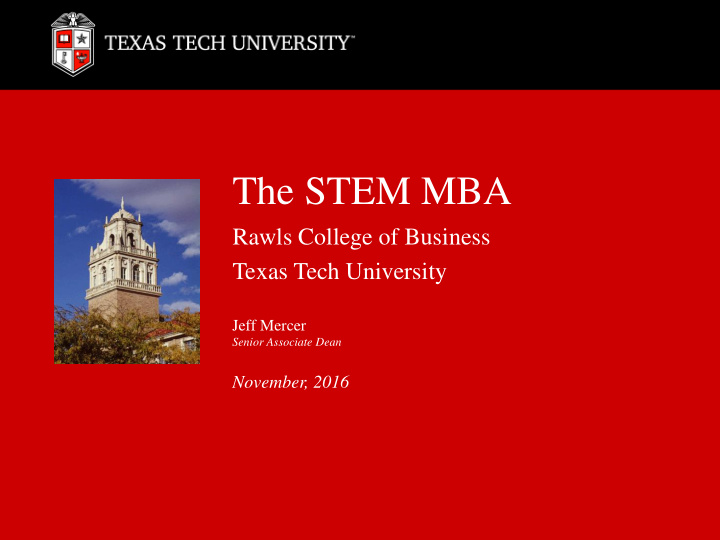



The STEM MBA Rawls College of Business Texas Tech University Jeff Mercer Senior Associate Dean November, 2016
PURPOSE • Discuss trends in MBA programs. • Describe the intent of the STEM MBA program at Texas Tech University. • Review current status of the program.
MBAs for Specialized Audiences The STEM MBA at Texas Tech University Problems We Faced
PROBLEMS WE FACED PROBLEM 1: Serving too many markets . Full-Time MBA (with over 15 concentrations) Part-Time Night MBA Physician’s MBA Attorney’s MBA Working Professional MBA (Weekend and Week-Block) Dual degrees with over 10 programs outside the college MS degrees in Acct, Fin, Mgmt, Stat, MIS, HOM We were spread too thin!
PROBLEMS WE FACED PROBLEM 2: Isolation Largest city between I25 and I35 BUT, in the middle of nowhere!
PROBLEMS WE FACED Question : How do we convince Dallas professionals to quit a $100,000 / year job to come to Lubbock for an MBA?
PROBLEMS WE FACED PROBLEM 3: Ranking penetration Business schools do not want to give up their ranking! (even if you ask them nicely)
WHAT DID WE HAVE TO WORK WITH? Large University – 33,000 students Good Reputation – primary university in western part of the state, appreciated in DFW and Houston Great Facilities – brand new building, beautiful campus Faculty – values good instruction, many with STEM degrees and experience Administration – willing to experiment, take a risk
GAME PLAN • Eliminate programs with low participation. • Focus on programs with high placement and quality. • Create a specialty MBA in a niche area: STEM MBA
MBAs for Specialized Audiences The STEM MBA at Texas Tech University What is a STEM MBA?
WHAT IS A STEM MBA? Participants : Undergraduate degree in S cience, T echnology, E ngineering or M athematics (STEM) Duration : One Year Style : Cohort (starting Fall, Spring, or Summer) Location : Same Room throughout Program
WHAT IS A STEM MBA? Program Characteristics Format : 42 Hour program • 36 hours on campus; completed within a year • 6 hours distance; can be taken before, during, or after on campus program (many take while still in undergraduate program) Curriculum : • 30 hours MBA Core • 12 hours STEM oriented “electives”
WHAT IS A STEM MBA? How does content differ from other MBAs? Not just a change in audience. Core classes are similar to other programs, BUT examples and cases are STEM related. • Not used: Wal-Mart, McDonalds, Banks • Used: Energy, Chemical, Manufacturing, Technology, Healthcare, Pharma • Business law emphasizes intellectual property Non-Core courses focus on STEM topics • Commercialization • STEM Theories in Practice • Technical Communications
WHAT IS A STEM MBA? STUDENT DEMOGRAPHICS 50% Engineers 40% Hard Sciences 5% Soft Sciences 5% Math Unexpected participants: • “Gap Year” medical students • PhD/MS students in biotechnology
MBAs for Specialized Audiences The STEM MBA at Texas Tech University Why a STEM MBA?
WHY A STEM MBA? Our initial thoughts regarding a STEM emphasis: • Innovative and unique • National emphasis on STEM education • Potential participants on Texas Tech campus • Non-problematic job placement
WHY A STEM MBA? Program philosophy You entered your undergraduate to become an engineer or scientist. We do not want to convince you to become accountants and bankers. Emphasis: Bring your scientific Learn management and and engineering leadership skills that ideas to the market will make you a better place. engineer and scientist.
WHY A STEM MBA? Program philosophy BUSINESS A STEM core and business shell will STEM give you an edge CORE in the workplace. SHELL
MBAs for Specialized Audiences The STEM MBA at Texas Tech University Evaluating the Potential (what we thought about before implementing a STEM MBA)
EVALUATING THE POTENTIAL Three factors we considered: • Market – Can we fill chairs? • Resources – Are we capable? • Benefits – Is it worth it?
EVALUATING THE POTENTIAL Market – Can we fill chairs? What audience will find appealing? Who is offering similar programs? Alabama Purdue How will the program be promoted? (“If you build it, they will come” does not work.) Will existing programs be cannibalized? Is the market sustainable? (Will it exist ten years from now?)
EVALUATING THE POTENTIAL Market – Program evolution (and trends) Established Waning Emerging Programs Programs Programs • Specialized MBAs • Professional MBAs • Full Time MBAs ? • Executive MBAs (Healthcare, Energy) (the Wake Forest • Corporate MBAs • Part-Time MBAs experiment) • MS in Accounting (tailored and on site) • MS in Data Science (Big Data, Analytics)
EVALUATING THE POTENTIAL Market – The marketing landscape has changed: Old School • Pamphlets • Static Websites • Mail Outs • Grad Fairs Conclusion: We need to adapt!
EVALUATING THE POTENTIAL Market – What made STEM students perfect for us? • Texas Tech is known for engineering and science. • Reputation as hard workers. • Most have coop or internship experience. • High level of cooperation between our college and Engineering / Arts and Science.
EVALUATING THE POTENTIAL Resources – Are we capable? Is there faculty expertise? Is there classroom space available? Will our technology accommodate instructional and distance aspects of the program? Do faculty members have expertise to deliver distance aspects of the program?
EVALUATING THE POTENTIAL Resources – Participating faculty typically: • Have a STEM undergrad • Worked in STEM profession • Research using STEM related data
EVALUATING THE POTENTIAL Benefits – Is it worth it? Does the program fit the mission of the college/university? Is there administrative support? Can graduates be placed in productive careers? Does the program bring recognition to the college (ranking? publicity?) Will the program generate formula funding?
RESULTS The numbers: Pre-STEM First Year Second Year MBA STEM MBA STEM MBA Summer/Fall/Spring 2013-14 2014-15 2015-16 Enrollment 40 64 90 Average GMAT 520 558 596 Average 3.34 3.31 3.42 Undergraduate GPA
RESULTS Beyond the numbers : • Strong cohort comradery • Market differentiation (but attempts to imitate) • Ranking improvement • Nice publicity
Recommend
More recommend